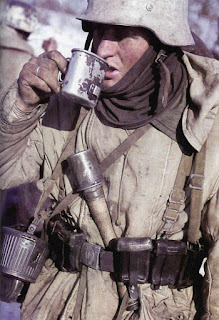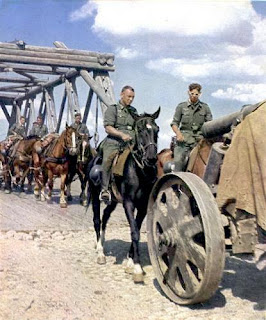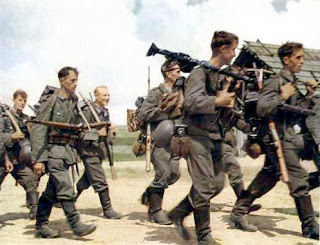In Brief
This is an excellent book. At something over 500 pages it might appear daunting at first glance. But considering how much is covered - from the blitzkrieg in Poland and France, to the heat of North Africa or the cold of Russian winters; from heady victories to abject defeats, on the frontline and in the occupied rear areas - it's actually remarkably concise.
Over twenty-four chapters, subdivided into five parts whose headings pithily map the narrative trajectory - Military Ascent, Moral Decline; Triumph & Hubris; Losing The Initiative; Beleaguered; Defeat, Destruction & Self-Destruction - Ben Shepherd both tells the story and analyses the actions of the German Army between 1933-45.
Victories came easily in the early days.
I don't want to give too much away for readers coming to this fresh, a great deal of whom will probably know much of the history beforehand anyway. But, in brief, Hitler's brinkmanship and the army's own 'auftragstaktik' doctrine (something Shepherd makes much of) initially appear to serve the German cause well.
But, ultimately, the huge gulf between ends and means, and the toxic racism central to Nazi ideology, ensure that the rot sets in very quickly. Once the regime's brutal belligerence - the army being a chief tool in this respect - has angered and alienated a large enough coalition, the 'thousand year Reich' and the army used to create it, are doomed to an early demise.
But, ultimately, the huge gulf between ends and means, and the toxic racism central to Nazi ideology, ensure that the rot sets in very quickly. Once the regime's brutal belligerence - the army being a chief tool in this respect - has angered and alienated a large enough coalition, the 'thousand year Reich' and the army used to create it, are doomed to an early demise.
Bogged down in Russia.
This comprehensive and compelling account is, above all else, a very nuanced and balanced reading of this dark and messy chapter of recent history. And as the books subtitle, The German Army in the Third Reich, suggests, as well as simply telling us what happened, Shepherd examines the context, asking such questions as how complicit was the German army in Nazi atrocities? and why did it continue to fight so ardently when it was clear the war was lost?
A woman weeps as Jews are rounded up in Greece.
This pic is from Albania. The war in the Balkans was, as in Russia, very brutal.
Journeying throughout the varied theatres of this monumental conflict with the German armed forces, as Shepherd seeks the answers to these questions, was fascinating and enlightening. A sure-fire sign that a book is worth reading is when it's hard to put down, and stokes the fires of interest in further, deeper reading. This book assuredly does both.
Up next: I wanted to get this when it first came out in hardback, but managed to wait till the cheaper paperback (as pictured) arrived.
In Depth (well, a bit more depth, anyway...)
As alluded to at the end of the brief review above, there were aspects of the content of this book that intrigued me, regarding further future reading. As it happened, at one of the recent '40s events we attended, I picked up the memoirs of Panzer General von Mellenthin, a German commander I'd not heard of before, but who Shepherd quotes a number of times.
I'm reading this now.
But as well as getting better knowledge of the source material, there are whole other areas, such as the conflict between the various commands (e.g. the OKH and the OKW), and the growing encroachment of the SS upon the army's roles, or the individual campaigns, all of which excite interest in further exploration.
Some of the other things that I found interesting here include the following: the concept of auftragstaktik; the different faces of occupation, from the relatively civilised [1] west to the openly and deeply barbaric east; individual campaigns (pretty much all of them, but perhaps especially the blitzkrieg in France, Barbarossa, and the campaign in Italy); and the roles of other arms, e.g. the Luftwaffe and Kriegsmarine.
Brauhitsch, an old-school German commander, of aristocratic origin. He had a chequered career, in and out of favour. Despite his high rank (field marshal, and even C-in-C in the early part of the war), he was often sidelined. Whilst conspiring with Halder to try and get rid of Hitler somehow, as early as 1939-40, he ultimately backed out. Surviving the war he died in captivity, before he could be brought to trial.
Jodl was one of the new breed at the top of the german army. A frontkampfer in WWI (and therefore more like both Hitler and his ideal of the new Nazi soldier), who rose through the ranks, ultimately signing both the infamous 'commissar order' (1941), and the unconditional surrender (1945). He was hanged in 1946 for war crimes
Some of this involves reflecting on the content of what this book covers (the german army's doctrine of auftragstaktik would be a case in point, as would their complicity in Nazism's ideological crimes), and other aspects involve delving deeper into stuff Shepherd only has time/space to briefly allude to.
One good example of the latter case would be the way that, at the outset of the war, the germans combine arms very successfully. Whereas, by the middle of the war, and ever more so as it goes on, they are reduced to a one-dimensional force: once they lose air and sea supremacy they only have the edge (if they ever have any advantage at all), or just a fighting chance, on land.
Combined arms: look very carefully and you'll see a diving Stuka in this pic.
The bulk of german armour early in the war was light, such as the Pz I, Pz II, Pz38s (Czech chassis!), with only a few Pz III and IV.
An iconic image of Blitzkrieg in France.
Planes such as these Stukas played a vital role in early german victories, psychologically as well as tactically.
So, when the German Army invades France the Luftwaffe's dominance in the air is crucial to the success on the ground. And likewise, at the other end of the war, as they retreat from France, it's lack of air support (never mind supremacy!) that is decisive in sealing their doom, as manoeuvres can only be carrie out at night, and the transport infrastructure is constantly hammered by the Allies.
Auftragstaktik is a term that creates difficulties in explanation, even for the experts (check this link, to see what I mean), including, to some degree, Shepherd himself. Interestingly, it is very different from the Napoleonic style of command - something Hitler would aim to emulate ever more as the war progressed - whereby the central commander knows and directs all, and only tells subordinates the minimum they need to know to execute his will. Auftragstaktik, by contrast, very much depends on knowledge, flexibility, and independence, all the way down the chain of command, but especially at the 'sharp end'.
Rommel, in North Africa.
Guderian gets lambasted.
Some commanders emerge from this account relatively okay, although very few (if any) could claim to be to be free from the taint of implanting Nazi policy. Rommel is taken down a peg or too from his most exalted myth, but not trashed as some have seen fit to do. Guderian is portrayed more hardly still, as a self-serving careerist, who overstates his own importance, happily sacrificing others, from rank and file to high level colleagues, in furthering his own ambitions.
Shepherd certainly focusses a lot on how the officer corps composition evolves, away from the old-school Prussian aristocratic model (ready enough to embrace Nazi militarism as it was) to the broader volksgemeinschaft of Hitler's Nazi vision, a classless meritocracy (of sorts!), in which bravery and fanaticism were key components. Schörner emerges from Shepherd's account as the exemplary of this latter type. A leader who could be as brutally terrifying to his own troops as the enemy!
To combat escalating desertion rate ardent Nazi commander Ferdinand Schörner implemented an infamous order requiring on the spot court-martials and hangings for troops found separated from their units.
Shepherd makes good use of material from the lower ranks as well, often quoting from letters home. So, to finish off this review, here are some pictures of the more rank and file type elements.
Landser... trudging through the vast Steppe.
Panzergrenadiers of the GrossDeutschland regt.
A nice colour image from the german magazine Signal.
War whatever the weather.
Despite her much vaunted mechanisation, and those feared Blitzkrieg weapons the Panzers, Germany remained heavily reliant on old-fashioned horsepower.
Still trudging through the Steppe.
I forget the exact figures Shepherd gives for German wartime casualties, but I thinks it's something like 700,000 on the Western Front and 1,700,000 on the Eastern Front. [2] Many more were missing and never accounted for, and of course many more were wounded. Again, my memory for the figures is hazy. But I think Germany mobilised about 9,000,000 of their armed forces, during the war as a whole.
These kids are actually SS (Totenkopf). By the end of the war Hitler and Germany were scraping the barrel, rather like the Marie-Louises of the Napoleonic era.
----------
NOTES:
Shepherd's book is illustrated, chiefly with a section of pics in the middle. The pics I've used here are not from his book, but Wikipedia and the web in general.
[1] I say relatively advisedly. Whilst the Germans might have enjoyed civilised relations, especially initially, with the social/racial groups they considered their equals, such as the French, or the Germanic/Nordic peoples, the army was heavily complicit in enacting Nazi racist policy as regards the 'out groups', with the Jews being the primary target.
[2] I thought I'd check on Wikipedia, but it's clearly a messy and complex subject, as this link demonstrates.
























No comments:
Post a Comment